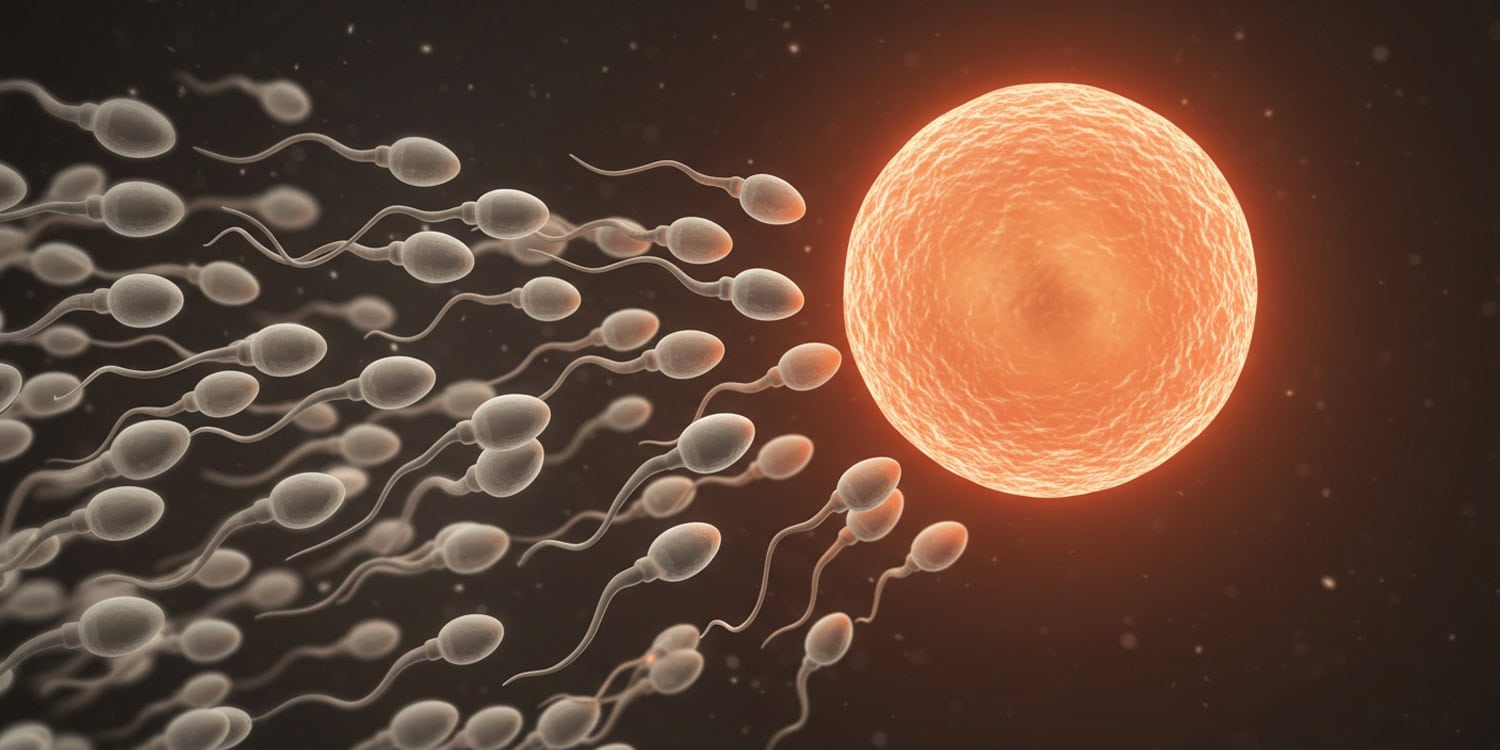A new study published in the Archives of Sexual Behavior provides evidence that men’s sperm quality is influenced by how many potential sexual rivals they believe their partner has. Men who thought their partner was more likely to spend time with other men produced ejaculates with higher sperm concentration during intercourse. This suggests that men’s bodies could be biologically (but unconsciously) tuned to respond to perceived competition in ways that enhance their chances of fathering children.
But the scientists behind the study also uncovered a paradoxical twist: men who believed their partners were more faithful actually produced ejaculates with a higher concentration of rapidly moving sperm.
Sperm competition is observed in many animal species. It occurs when sperm from multiple males are present in a female’s reproductive system at the same time, vying to fertilize her egg. In species where females might mate with more than one male, males have evolved various strategies to increase their reproductive success in this competitive environment. Some of these strategies involve producing larger quantities of sperm or sperm of superior quality.
Previous research in humans, notably a study conducted in the early 1990s, proposed that men might also exhibit this kind of biological adaptation. That earlier study suggested that men produce ejaculates with more sperm when they have spent less time with their partner since their last sexual encounter. The reasoning was that time apart could signal a higher risk of sperm competition, as it presents opportunities for a partner to potentially engage with other men. However, this initial research relied on just one measure of sperm competition risk – time spent apart – and used older methods for analyzing semen.
Recognizing the limitations of past work, a team of researchers aimed to revisit and expand upon these findings using more comprehensive measures of sperm competition risk and advanced semen analysis technology. They wanted to investigate whether factors beyond just time apart, such as a man’s perception of his partner’s potential infidelity or the presence of other men who could be seen as rivals, might also influence ejaculate quality. Furthermore, they sought to employ modern laser-optic technology to gain a more precise understanding of semen characteristics.
“I had always been interested in human mating behavior from an evolutionary perspective, but my interest in human sperm competition started back in 2007 when I first heard about Baker and Bellis’ research on the subject that they conducted back in 1993,” said study author Tara DeLecce, a postdoctoral researcher and special lecturer at Oakland University and co-editor of The Oxford Handbook of Infidelity.
“The idea that sperm from multiple males compete in the female reproductive tract to fertilize ova, and that competition could occur on such a microscopic level and be affected by sociosexual factors (time spent apart, rival males) was such a novel and unusual concept to me. Once I became aware of it, I just wanted to learn more, and I couldn’t really get my mind off of human sperm competition since then. My dream has been to replicate this study by Baker and Bellis and I was grateful for the opportunity to join and assist in a lab that was already in the process of replicating this study with improved methodologies.”
To conduct their investigation, the researchers recruited 34 heterosexual couples from a university community. The participants were between 18 and 32 years old. All couples were in committed, sexually active relationships lasting at least three months. The researchers ensured that the male participants had not had a vasectomy or undergone fertility treatment, and that the female participants were not using hormonal birth control. This careful selection helped to control for factors that could independently affect fertility.
Over a 45-day period, each couple participated in seven sessions with the researchers. In the initial session, the partners were separated and asked to complete questionnaires about their relationship and perceptions of sperm competition risk. These questionnaires assessed several factors. One was the amount of time the couple had spent together since their last sexual encounter.
Another set of questions gauged the men’s perceptions of their partner’s potential infidelity, asking about the likelihood of past and future unfaithfulness. Finally, the men were asked to estimate the number of male friends and male coworkers their partners had, as well as how much time their partners spent with these men. Researchers also took some basic body measurements from each participant, such as height, weight, and waist circumference.
Following the first session, the couples were given materials and instructions for collecting six semen samples at home over the next 45 days. Three of these samples were to be collected after sexual intercourse with their partner using a special non-latex condom provided by the researchers. The other three samples were to be collected through masturbation. To ensure consistency, the men were asked to abstain from ejaculation for at least 48 hours, but no more than seven days, before each sample collection. For masturbation samples, they were instructed to refrain from using pornography or lubricants not provided by the study.
To maintain the quality of the semen samples, participants were given specific guidelines. After ejaculation, they were instructed to seal the condom or specimen container, wrap it in aluminum foil to keep it warm, and transport it to the lab within one hour, keeping it close to their body for warmth during transport. Upon arrival at the lab, researchers used a sophisticated machine called a Semen Quality Analyzer to assess various aspects of the semen. This machine uses laser technology to provide a detailed analysis of semen characteristics, including sperm concentration, the percentage of sperm that are moving effectively, and the total number of sperm.
DeLecce and her colleagues focused on these specific measures because they are commonly used in human sperm competition research and were also used in the earlier study they were replicating. They also considered other factors that are known to affect semen quality, such as the man’s age, body mass index, how long they had abstained from ejaculation, relationship length, and lifestyle habits known to potentially harm sperm, such as using heated car seats or laptops on laps.
Contrary to the findings of the earlier study, the researchers found that the amount of time a couple spent apart since their last sexual encounter was not related to any measure of semen quality. However, they did find that men produced semen with a significantly higher concentration of sperm when they perceived their partners as having a greater number of potential sexual rivals, specifically male friends and coworkers. This finding was specific to copulatory ejaculates; masturbatory ejaculates did not show the same pattern.
“Unlike Baker and Bellis’ original 1993 study, we did not find a relationship between time that couples spend apart from one another and number of sperm ejaculated at the couple’s next copulation,” DeLecce told PsyPost. “However, we did uncover another interesting finding related to sperm competition. Specifically, we found that men produce higher overall sperm concentration when they perceive that their regular partner has more male friends and coworkers, which could be considered potential rivals and thus a cue of higher sperm competition risk with appropriate ejaculate quality adjustment in response to this higher risk.”
Interestingly, while the concentration of sperm was higher in copulatory samples overall compared to masturbatory samples, the proportion of rapidly moving sperm was actually higher in masturbatory samples. They also found that men who reported fewer lifestyle habits known to be detrimental to sperm had a higher concentration of rapidly moving sperm. Older men and men who had abstained from ejaculation for a longer period produced semen with a greater total number of motile sperm. Unexpectedly, men who perceived their partners as more faithful actually had a higher concentration of rapidly moving sperm.
“There was a finding that went in the opposite direction of what would be predicted in terms of sperm competition,” DeLecce explained. “Men in the sample produced higher concentrations of rapid progressive motile sperm when they self-reported that they perceived their partner to be highly sexually faithful. To give more detail, rapid progressive motile sperm refers to sperm that swim faster relative to others and in a straight line as would be optimal to fertilize ova. Comparatively, slow progressive and nonprogressive motile sperm swim much slower and often do not swim straight (e. g. swim in circles), which would not allow them to effectively travel to the reproductive tract to reach the egg.”
“The principles of sperm competition would predict that perceptions of lower faithfulness or suspicions of infidelity would result in more rapid progressive motile sperm to adjust for heightened sperm competition risk. This might suggest that ejaculate adjustment in humans may be more complex than in other primate species, and additional research is warranted.”
The study, like all research, includes some caveats to consider.
“A notable limitation is that we did not directly ask the female members of the couples to self-report what activities they did engage in when they were apart from their male partner,” DeLecce noted. “From the male perspective, simply time away should be sufficient to serve as a cue to sperm competition risk; however, this could be further nuanced based on what the females report doing during this time away.”
“For instance, if there is an established work and/or social routine, this may not be considered much of a cue to possible infidelity compared to unexpectedly going out for drinks with a new group of mixed sex friends. Additionally, in the 1990s, there wasn’t the ability to text and be in constant contact, so perhaps time away would be considered a more significant cue of sperm competition relative to modern times in which frequent remote communication occurs and thus may mitigate possible concerns over infidelity. Lastly, we had a small sample of 34 couples, so the extent to which these findings generalize more widely is not known.”
Looking ahead, the researchers are continuing to investigate human sperm competition. They are interested in exploring whether exposure to visual or other sensory cues, such as images that suggest the presence of multiple rivals, might affect sperm quality in similar ways.
“Our lab’s goal is to get a better understanding of the extent to which sperm competition affects human mating dynamics, and how that relates to sperm competition in other species, which is more well-documented,” DeLecce explained. “To that end, our lab continues to research human sperm competition using various methodologies and hopefully using larger sample sizes. For instance, we are currently comparing masturbatory ejaculate quality in response to erotica featuring high sperm competition risk (multiple males and one female) compared to that featuring no sperm competition risk (all females).”
“I just want to make it clear that ejaculate adjustment as described in this paper in response to sperm competition risk is not something that happens at the conscious level,” she added. “In other words, men aren’t actively thinking to themselves, ‘My partner is behaving in a way that makes me suspicious of infidelity and therefore I’m going to increase my ejaculate quality at our next sexual encounter.’”
“Instead, this is thought to be an unconscious, evolved response to cues to infidelity to avoid cuckoldry, which refers to a man’s regular partner producing offspring with another man without his knowledge and then investing in such offspring as his own. In terms of evolution, this is a threat to male reproductive success, especially if the male being cuckolded produces no offspring that are genetically related to him with his regular partner; therefore, his genes would not survive into subsequent generations and there would likely be selection pressures in place to avoid this possibility.”
The study, “Ejaculate Adjustment in Response to Sperm Competition Risk in Humans,” was authored by Tara DeLecce, Gavin S. Vance, Virgil Zeigler‑Hill, Lisa L. M. Welling, and Todd K. Shackelford.




